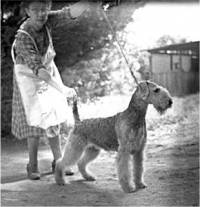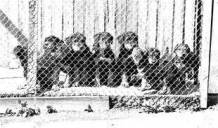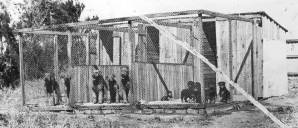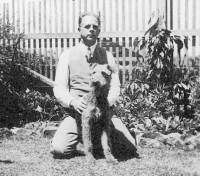Omuka Airedales
 Sister Garrard with Ch Omuka Monty
Sister Garrard with Ch Omuka Monty
Sister Garrard bred under the 'OMUKA' prefix. Her breeding began in 1936 began with a classy bitch by Ch STONLEIGH SOLARIO out of AUSTRAL VERA, bred by Norman Myers. Her kennels were in in St Kilda Road - almost in the 'heart' of Melbourne.
Then she imported two dogs - the first Airedale to come to Australia with an English show title Eng CH WOLSTANTON PAM and WOLSTANTON ROCKET. They produced Ch Omuka Obstacle a big winning dog who was luckily mated to Ch AIRLIE BRUNETTE before he come to an untimely death. But she carried on as World War Two came to a close when in 1944 she produced a litter containing OMULA FLASH, OMUKA G and OMUKA MONTY.[1]
Omuka Kennels
 Mae Platts with Eng Ch Wolstanton Pam (Imp UK)
Mae Platts with Eng Ch Wolstanton Pam (Imp UK)
The photo on the right is of Sister Garrard with Ch Omuka Monty. The second is of Mae Platts with ENG CH WOLSTANTON PAM. Unfortunately Pam had a soft coat which Sister Garrard used to dye her dogs with Condy's Crystals (Potassium Permanganate). Perhaps this story is true but I find it hard to believe because of other cruel stories that were spread around in those days. For example, because Sister Garrard worked for a dentist it was alleged that that one of her dogs had false teeth! One can only conclude that malicious 'stories' of cheating are as old as dog shows themselves!
The amazing pictures below have have survived on on glass slides for almost a century. They demonstrate that it was common place breeding facilities in Melbourne before the Second World War. The two pictures below are of Sister Gerrard's kennels. These amazing pictures give an insight into breeding facilities in Melbourne in the late 1930's.
 An 'Omuka' Litter c 1940
An 'Omuka' Litter c 1940 Omuka Kennels in St Kilda Road Melbourne
Omuka Kennels in St Kilda Road Melbourne
The Life of Sister Garrard
Gertrude Kate Garrard was born in 24/10/1886 in Tasmania and died 30/06/1975.She led an amazing life, trained as a nurse in Tasmania, as a mid wife in Adelaide and in 1914 was in New Zealand. She enlisted in the NZ army Nursing Service serving on the Maheeno at Gallipoli.At the end of the was she established the Ulverstone Private Hospital in Melbourne. After retiring in 1935 she devoted herself to Infant Welfare and assumed the care of John.
She began breeding Airedales, later Cairn Terriers and in 1951 Miniature Poodles. She imported a number of Minis from Firebrave Kennels of Mrs Munro in UK.Importantly in c1956 the third variety of Poodle was recognised by The Kennel Club and Sister Garrard imported the nine and a half inch Fircot Little White Rajah. He was the first of the POODLE toy Variety to arrive in Australia. He became very popular with the general public due to his appearance in an advertisement resting his head on a milk bottle with the caption "Mama says to Drinka Pinta Milka a Day." So popular that at the Royal Easter Show in 1960 he drew a record crowd of people to see him.Rajah retired in 1962 and died in 1971[2].
After World War 2 - 'Trixie's Story'
 Wilfred Thomas with 'Trixie'
Wilfred Thomas with 'Trixie'
As Sister Garrard attended the Royal Melbourne Show 1946 with a puppy called 'Omuka Obliging' she must have kept her kennels alive right through World War Two. At that Show she sold 'Omuka Obliging' to Mr Wilfrid Thomas. From then on she was just called 'Trixie'.
Wilfred was raised as one of a family of ten children. The family operated a market garden in Highbury Road, Burwood. Animals were a large part of the family's upbringing, especially one Airedale. So when Wilfred married and had a family of two girls himself what could be a better playmate for his daughters than another Airedale! So Trixie devoted the rest of her life to Wilfred's family.
 The Thomas Family with 'Trixie'
The Thomas Family with 'Trixie'
With family outings sitting up on the back seat of the car between the two girls, Trixie was strictly the family pet and was never exhibited at a dog show again. With her coat plucked out after each winter by finger and thumb, she was never strung up on a grooming table like Airedales are today. Instead, she and Wilfred sat together on the grass in her back yard while her coat was tidied up with finger and thumb and just a metal comb. As it was not common to use commercial dog food, Trixie was fed on fresh horse flesh purchased from the Camberwell Market and cooked vegetables. Although Trixie was never bred, de-sexing was not common either!
This story highlights just one of the many families who grew up with fond memories of owning an Airedale as the family pet because their parents had also spent happy childhood years knowing one. My sincere thanks to Beverley King (Thomas) who supplied the details of this story and for use of precious family photographs that have survived for more than half a century.
References and Further Reading
[1] Greta Florence 'Forty Years with Airedales in Victoria' Published in British Terrier Club of Australia Golden Anniversary, 1907 - 1957 Pages 101 - 105
[2] Information by Nola WESTREN (Alamoana) and supplied by Roslyn Thomas